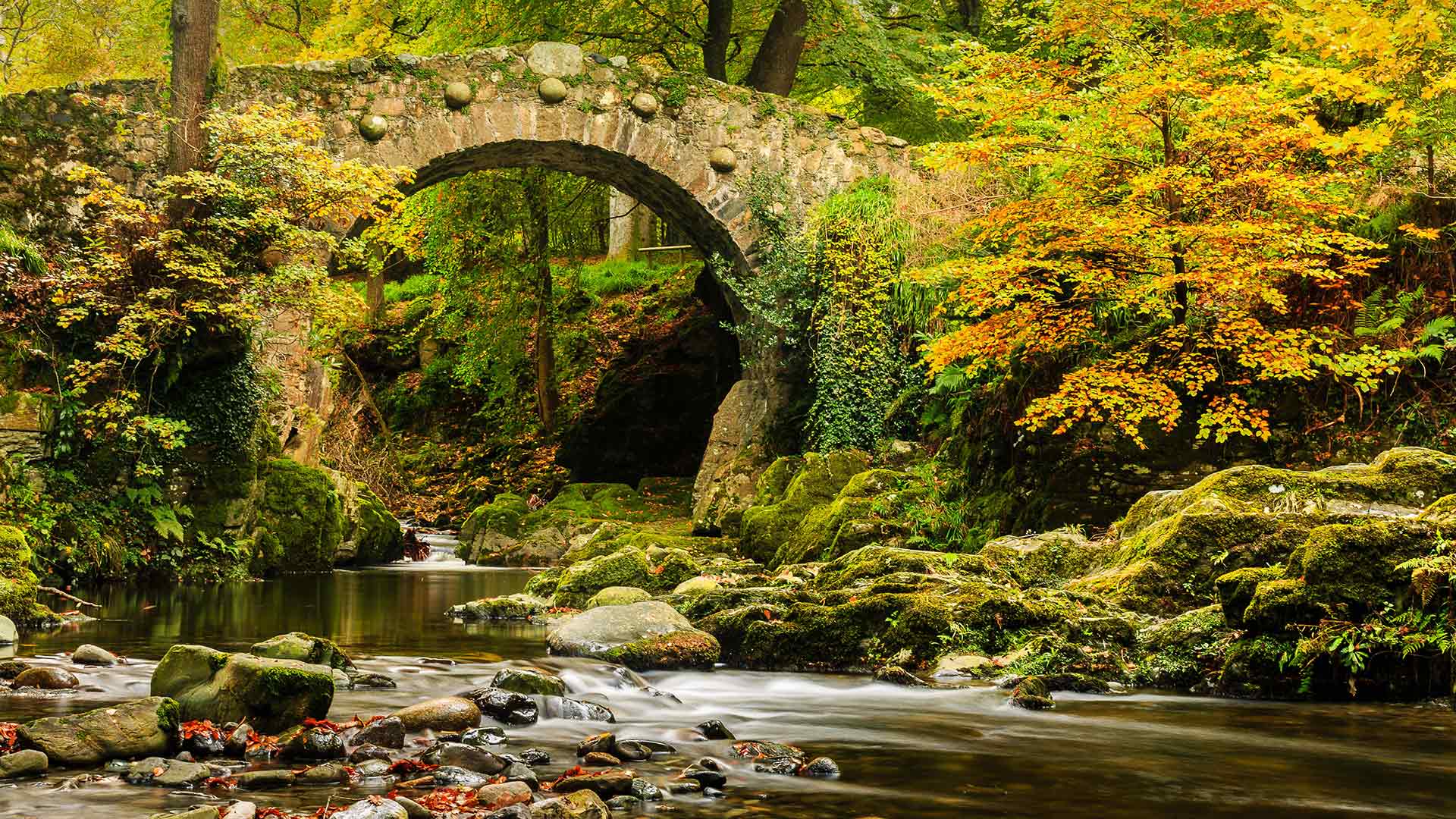标签 桥 下的文章
仙岩寺中的升仙桥,韩国曹溪山道立公园 Seungseon Bridge at Seonam Temple in Jogyesan Provincial Park, South Korea (© Aaron Choi/Getty Images)
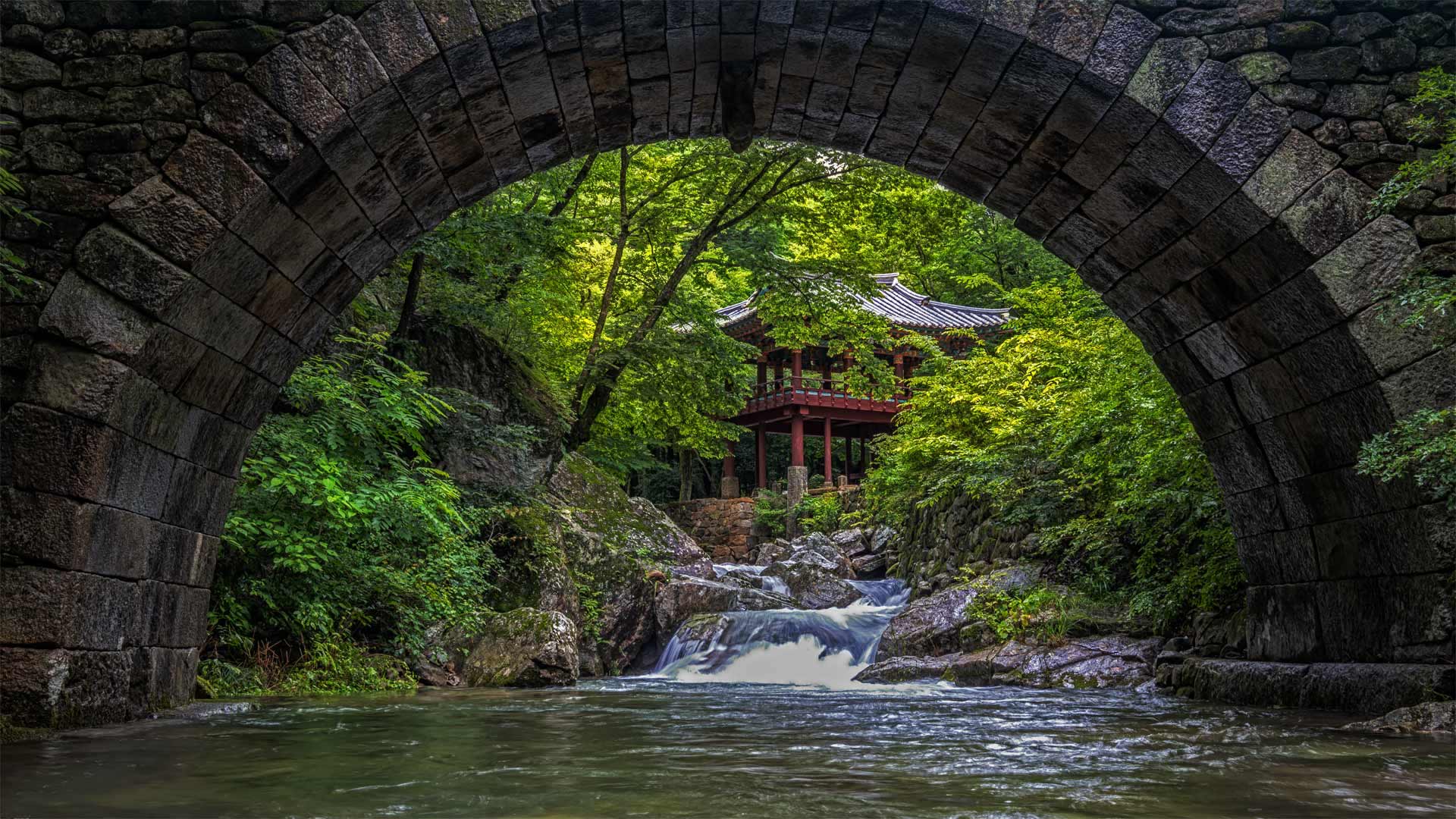
仙岩寺中的升仙桥,韩国曹溪山道立公园 Seungseon Bridge at Seonam Temple in Jogyesan Provincial Park, South Korea (© Aaron Choi/Getty Images)
连接过去和现在 Bridging past and present
Seonam Temple, South Korea
The Seonam Temple, or Seonamsa, in Jogyesan Provincial Park, South Korea, is famed for expressing calm serenity. Just downstream, Buddhist monks built this gently arched bridge by hand centuries ago. Stones around the base record the names of visitors for posterity. Called the Seungseon Bridge ('the Ascending Immortals'), it's fitting to approach the temple itself on foot, at one with nature. The site is hidden away in ancient trees, with tranquil ponds and streams, gentle hiking trails, and gorgeous pagodas. The temple still ekes out its day in the traditional way, with mellow bells and meditation. The monks also cultivate wild tea plants and are happy to share the benefits of the harvest. You are at peace as soon as you arrive at Seonamsa, and there's little to distract you from the present moment.
The original temple is believed to have been built in the 9th century, but over the years war and a major fire caused extensive damage, and it had to be rebuilt in the 19th century. Now the Seonam Temple is a UNESCO World Heritage Site, along with six other 'sansa,' or Buddhist monasteries, dotted in the mountains throughout the southern provinces of the Korean Peninsula. Visitors are invited to stay overnight at the temple and follow the monks' daily practice, but you can also dip in for a day to absorb the peace and tranquility. Flowers in spring and colorful leaf displays in fall make those the most popular times to visit.
韩国色南寺
位于韩国Jogyesan省立公园的Seonam庙(Seonamsa)以表达平静而闻名。就在下游,佛教僧侣在几个世纪前手工建造了这座轻轻的拱桥。基地周围的石头为后人记录了游客的名字。这座名为Seungseon Bridge(“升天神仙”)的桥适合步行接近寺庙本身,与大自然融为一体。该遗址隐藏在古树丛中,有宁静的池塘和溪流,温和的徒步小道,还有华丽的宝塔。这座寺庙仍然以传统的方式,用柔和的钟声和冥想来维持它的一天。僧侣们还种植野生茶树,并乐于分享收获的好处。你一到达梭南沙就很平静,没有什么可以分散你对当下的注意力。
据信,原来的寺庙建于9世纪,但多年来,战争和一场大火造成了巨大的破坏,不得不在19世纪重建。现在,色南寺与其他六座“三萨”或佛教寺院一起被联合国教科文组织列为世界遗产,分布在朝鲜半岛南部各省的山区。游客被邀请在寺庙过夜,并遵循僧侣们的日常修行,但你也可以泡一天来吸收和平与宁静。春天的鲜花和秋天五颜六色的树叶展览使这些地方成为最受欢迎的游览时间。
Ponte Gobbo桥,意大利博比奥 Ponte Vecchio bridge near Bobbio, Italy (© afinocchiaro/Getty Images)
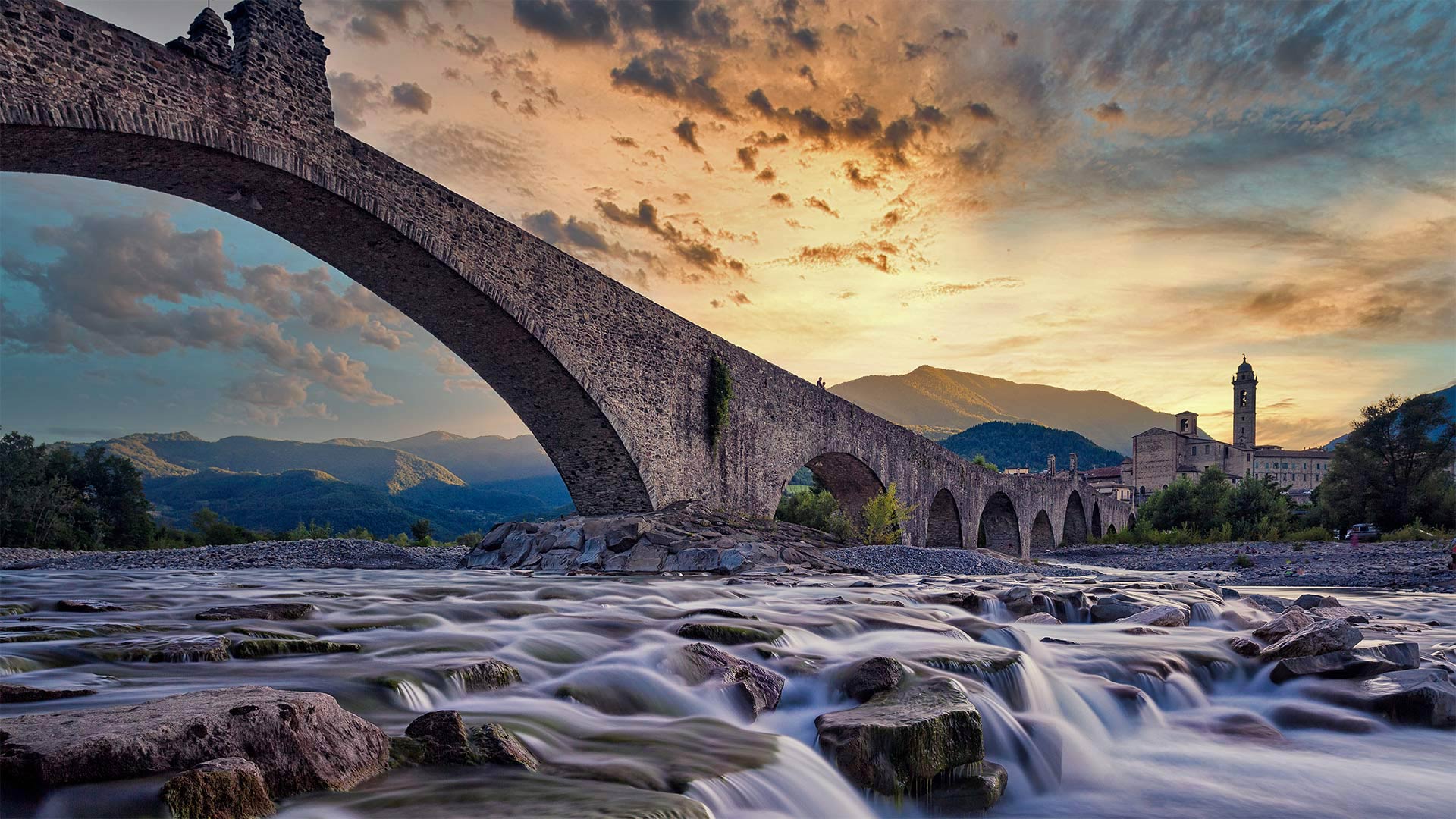
Ponte Gobbo桥,意大利博比奥 Ponte Vecchio bridge near Bobbio, Italy (© afinocchiaro/Getty Images)
特雷比亚河的左岸便是 On the left bank of the river Trebbia, lies...
Bobbio, Italy
Between the metropolis of Milan—the fashion and design capital of Italy—and the fabled seaport city of Genoa, you'll find this small river town in northern Italy. People have resided here since ancient times, including the Romans, but the town really began to flourish when the abbey was constructed in the 7th century. For much of the Middle Ages, the Bobbio Abbey and its vast library made the town a center of religion, culture, and learning.
These days, Bobbio is a regular tourist stop perhaps best known for its old bridge, or Ponte Vecchio (not to be confused with THE Ponte Vecchio in Florence). Bobbio's old bridge spans the river Trebbia with 11 arches of unequal size and is commonly called Ponte Gobbo (Hunchback Bridge), because of its irregular shape.
Bobbio remains a jewel box of a town frozen in time. With its many small churches, modest houses, and cobblestone streets, Bobbio maintains the character of a medieval village nestled the Trebbia valley. Ernest Hemingway described the Val Trebbia as 'the most beautiful in the world,' and with views like this, who could argue with him?
意大利博比奥
在意大利时尚和设计之都米兰和传说中的海港城市热那亚之间,你会发现这个意大利北部的小河镇。自古以来,这里就有人居住,包括罗马人,但当修道院于7世纪建成时,这座城镇真正开始繁荣起来。在中世纪的大部分时间里,博比奥修道院及其巨大的图书馆使该镇成为宗教、文化和学习的中心。
如今,博比奥是一个固定的旅游站,也许最著名的是它的老桥,或者叫Vecchio桥(不要和佛罗伦萨的Vecchio桥混淆)。博比奥的旧桥横跨特雷比亚河,有11座大小不等的拱门,因其形状不规则,通常被称为“驼背桥”(Ponte Gobbo)。
博比奥仍然是一个被时间冻结的城镇的珠宝盒。博比奥有许多小教堂、简陋的房屋和鹅卵石街道,保持着特雷比亚山谷一个中世纪村庄的特色。欧内斯特·海明威(Ernest Hemingway)将瓦尔·特雷比娅(Val Trebbia)描述为“世界上最美的”,有这样的观点,谁能和他争论呢?
托利莫尔森林公园的弗利桥,英国北爱尔兰 (© Adrian McGlynn/Alamy)
伊丽莎白女皇码头桥,澳大利亚珀斯 Elizabeth Quay Bridge in Perth, Australia (© Amazing Aerial Agency/Offset by Shutterstock)
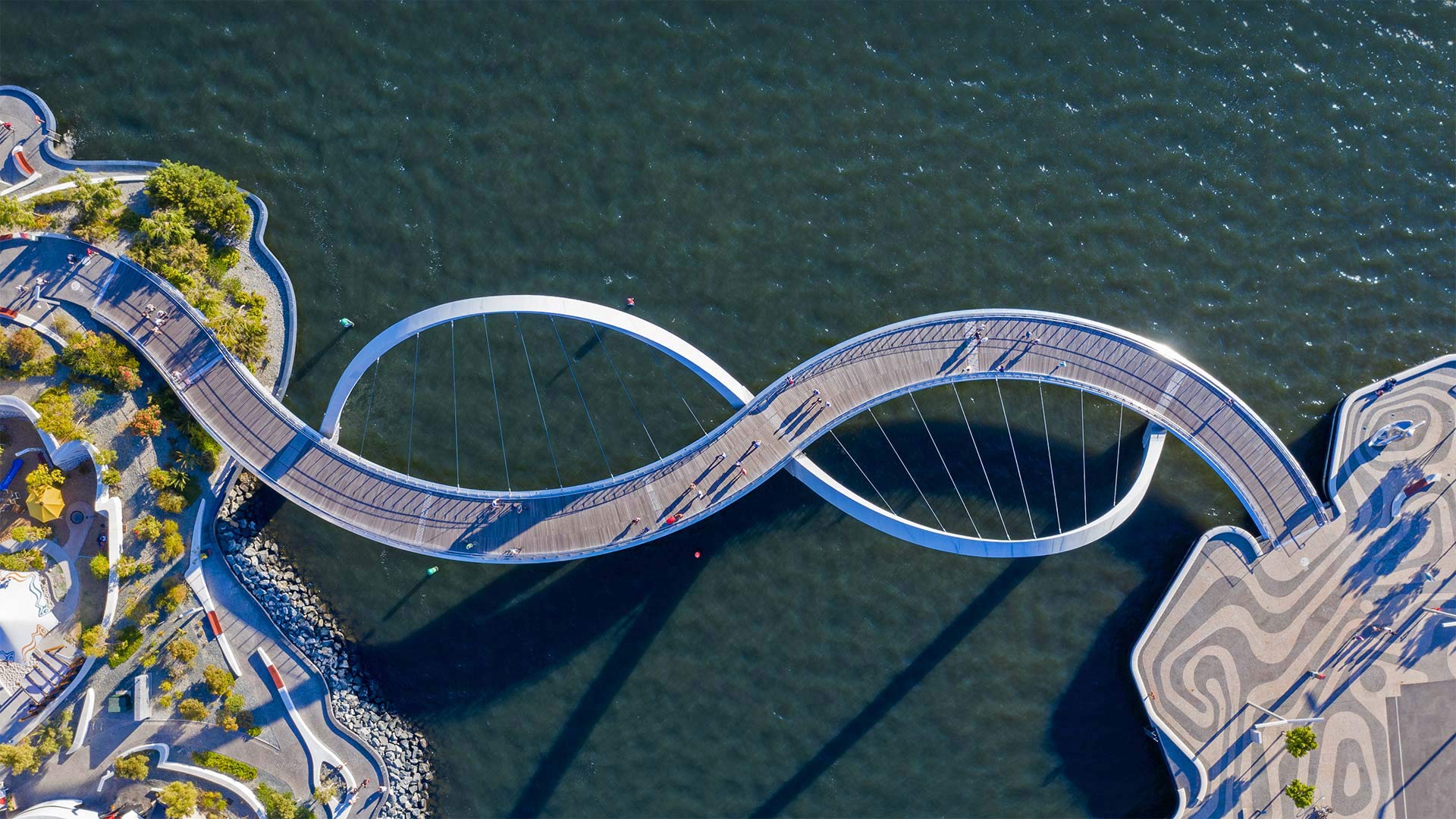
伊丽莎白女皇码头桥,澳大利亚珀斯 Elizabeth Quay Bridge in Perth, Australia (© Amazing Aerial Agency/Offset by Shutterstock)
Bridge to infinity
Infinity Day has us visiting Perth, Australia, and the Elizabeth Quay Bridge. From this aerial view, the bridge closely resembles a tilted ∞, the common symbol for infinity first popularized in a 17th-century mathematical text. We recognize this unofficial holiday every August 8, because the number 8 resembles the infinity symbol, and the eighth day of the eighth month is an infinitely superior day to celebrate the infinite.
View this bridge from ground level and you'll quickly realize that the graceful figure-8 seen from above is something altogether different when viewed from below. The architects behind this bridge designed it to dramatically link the Swan River with the city. The upper left and bottom right curves seen in this image are actually double arches that loop up and then under a 360-foot pedestrian and bicycle pathway. This pathway offers striking views of Perth's central business district and links the area with the newly developed Elizabeth Quay mixed-use development, featuring shops, cafés, apartments, and bars. If you do ever have a chance to take a walk on this bridge, we recommend taking a moment to ponder the infinite, just like the mathematicians and philosophers of the 17th century did.
通向无限的桥梁
“无限日”让我们参观了澳大利亚的珀斯和伊丽莎白码头大桥。从鸟瞰图上看,这座桥非常像一座倾斜的桥∞, 无穷大的通用符号首次在17世纪的数学文本中普及。我们每年8月8日都会庆祝这个非官方的节日,因为数字8类似于无限的符号,而8月的第八天是庆祝无限的一个非常好的日子。
从地面上看这座桥,你会很快意识到从上面看到的优美的8号图形与从下面看到的完全不同。这座桥背后的建筑师将其设计成戏剧性地将天鹅河与城市连接起来。图中左上角和右下角的曲线实际上是双拱门,在一条360英尺长的人行道和自行车道下循环。这条小路可以看到珀斯中央商务区的醒目景色,并将该地区与新开发的伊丽莎白码头(Elizabeth Quay)混合用途开发区连接起来,以商店、咖啡馆、公寓和酒吧为特色。如果你有机会在这座桥上散步,我们建议你花点时间思考一下无限,就像17世纪的数学家和哲学家那样。
鸟瞰罗伊斯河上的教堂桥,瑞士卢塞恩 (© Neleman Initiative/Gallery Stock) Aerial view of Chapel Bridge over the river Reuss in Lucerne, Switzerland (© Neleman Initiative/Gallery Stock)
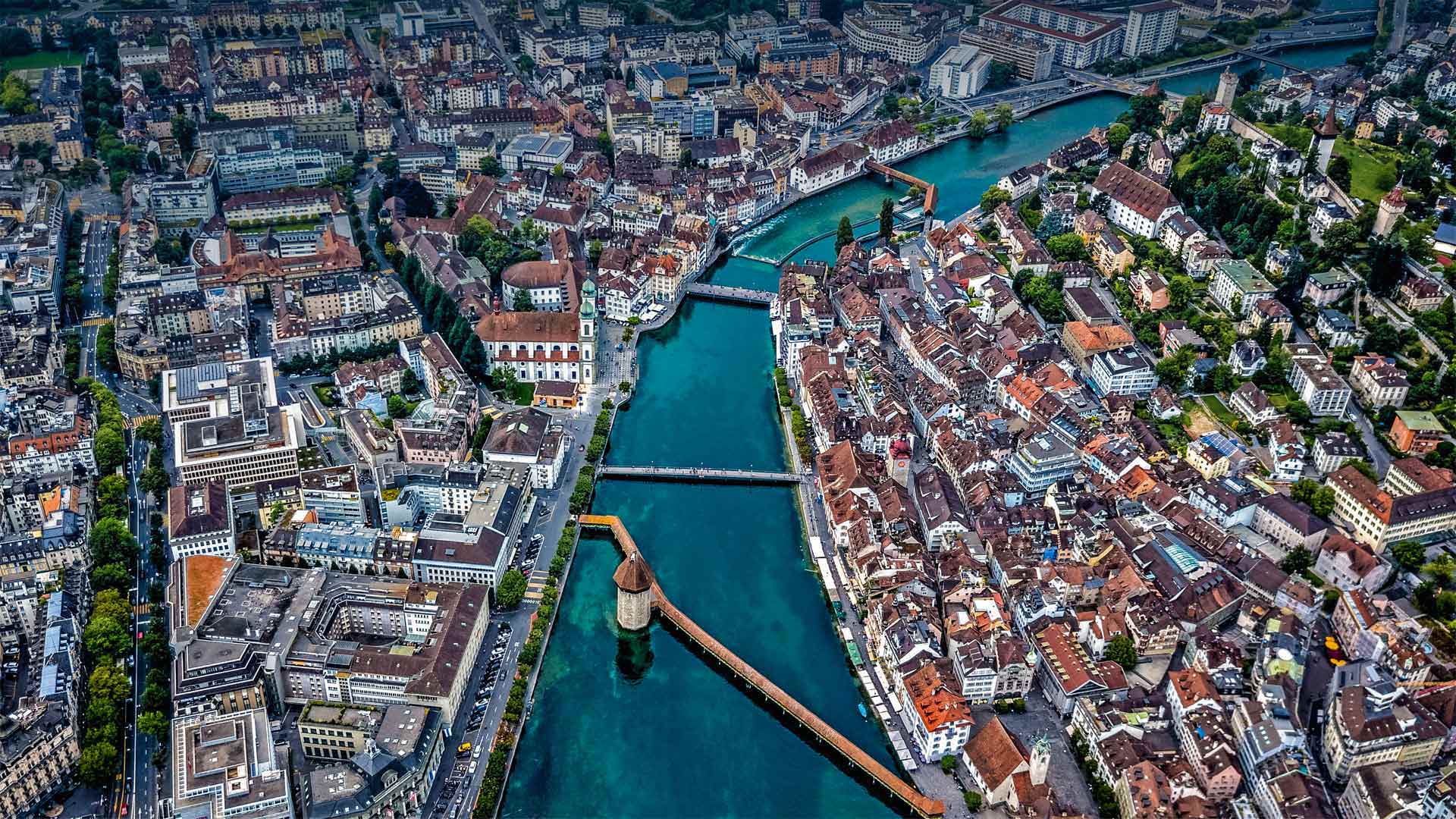
鸟瞰罗伊斯河上的教堂桥,瑞士卢塞恩 (© Neleman Initiative/Gallery Stock) Aerial view of Chapel Bridge over the river Reuss in Lucerne, Switzerland (© Neleman Initiative/Gallery Stock)
A Swiss city of bridges
We're in the heart of Switzerland looking down on the compact city of Lucerne, a charming waterfront setting along the shores of its namesake lake and the river Reuss. Surrounded by snow-capped mountains just out of frame, Lucerne lies in the Swiss-German speaking part of central Switzerland and is divided into two parts linked by a series of bridges. The most famous of these bridges—the centerpiece and symbol of Lucerne—is the Kapellbrücke (Chapel Bridge), a covered wooden footbridge which you can see spanning diagonally across the Reuss in our photo. The building rising from the river alongside the footbridge is a medieval water tower, which has been used as a prison, torture chamber, local archive, and treasury.
Originally built in 1333 as part of Lucerne's fortifications, Chapel Bridge connected the old town on the right bank of the Reuss to the new town on the left, securing the city from attack via Lake Lucerne to the south. It is believed to be the oldest covered wooden bridge in Europe, as well as the world's oldest surviving truss bridge, although much of it had to be replaced after a devastating fire in 1993. Named for the nearby St. Peter's Chapel—the oldest original church structure in Lucerne—Chapel Bridge is picturesque in more ways than one: There are dozens of interior paintings on triangular panels underneath the bridge's roof that date back to the 17th century. The paintings by local Catholic artist Hans Heinrich Wägmann depict historical events from the town, and despite the fire destroying most of the artwork, you can still admire some of the original paintings when crossing the river.
瑞士桥梁之城
我们在瑞士的中心,俯瞰着紧凑的城市卢塞恩,这是一个迷人的海滨城市,坐落在与之同名的湖和雷乌斯河沿岸。卢塞恩位于瑞士中部讲瑞士德语的地区,四周是刚出格的雪山,被一系列桥梁连接起来,分成两部分。这些桥中最著名的是卡佩尔布桥——卢塞恩的中心和象征ü教堂桥(Chapel Bridge),一座有盖的木制人行天桥,你可以在我们的照片中看到它斜跨在罗伊斯河上。沿着人行天桥从河里拔地而起的建筑是一座中世纪的水塔,它曾被用作监狱、刑讯室、地方档案馆和国库。
教堂桥始建于1333年,是卢塞恩防御工事的一部分,它连接了罗伊斯河右岸的老城和左岸的新城,通过卢塞恩湖向南保护城市免受攻击。它被认为是欧洲最古老的有盖木桥,也是世界上现存最古老的桁架桥,尽管在1993年的一场毁灭性的火灾后,大部分建筑不得不被替换。卢塞恩教堂桥最古老的原始教堂结构以附近的圣彼得教堂命名,但它在许多方面都如画如画:桥顶下的三角形面板上有几十幅室内画,可以追溯到17世纪。当地天主教艺术家汉斯·海因里希Wä格曼描绘了镇上的历史事件,尽管大火烧毁了大部分艺术品,但过河时你仍然可以欣赏到一些原作。
斯洛文尼亚索奇河上的木制吊桥上骑自行车的人的鸟瞰图 Aerial view of cyclists on a wooden suspension bridge over the river Soča in Slovenia (© Amazing Aerial Agency/Offset by Shutterstock)

斯洛文尼亚索奇河上的木制吊桥上骑自行车的人的鸟瞰图 Aerial view of cyclists on a wooden suspension bridge over the river Soča in Slovenia (© Amazing Aerial Agency/Offset by Shutterstock)
Get on your bike and ride
In honor of the UN's World Bicycle Day, we're at Triglav National Park in Slovenia, with a birds-eye view of riders crossing this dubious-looking wooden suspension bridge over the glacial blue water of the river called Soča. Protecting some of the most magnificent mountain landscapes of the Julian Alps, Triglav is the country's only national park, but it's a stunner. Running along Slovenia's northwestern border with Italy, Triglav was first protected as a 'conservation park' in 1924, then made a national park in 1981. The park gets its name from the mountain at its heart, Triglav, long considered a symbol of Slovenia and of Slovene identity.
Since 2018, the UN General Assembly has recognized June 3 as World Bicycle Day to honor 'the uniqueness, longevity, and versatility of the bicycle, which has been in use for two centuries.' The bicycle has gone through many iterations since Karl Drais created the brake-less, pedal-less bike forerunner called a 'velocipede' in 1817. The German inventor would likely be floored by today's variety of bike options, from new lightweight road bikes to heavier mountain bikes with fatter, knobby tires designed to handle rougher terrain. More than 200 years after von Drais introduced his two-wheeled contraption, bicycles remain as popular as ever. Chances are there's one just waiting for you to take it for a spin, and what better day to do so than World Bicycle Day?
骑上你的自行车
为了纪念联合国的世界自行车日,我们来到了斯洛文尼亚的特里格拉夫国家公园,鸟瞰着骑手们穿过这座看起来可疑的木制吊桥,桥上是一条蓝色的冰川河,这条河被称为Soča。特里格拉夫保护着朱利安阿尔卑斯山上一些最壮丽的山景,是这个国家唯一的国家公园,但它是一个惊人的奇迹。特里格拉夫位于斯洛文尼亚西北部与意大利交界处,1924年首次作为“保护公园”受到保护,1981年被列为国家公园。该公园的名字来源于其核心山脉特里格拉夫,长期以来被认为是斯洛文尼亚和斯洛文尼亚人身份的象征。
自2018年以来,联合国大会将6月3日定为世界自行车日,以纪念自行车的独特性、长寿性和多功能性,这种自行车已经使用了两个世纪。自从卡尔·德赖斯发明了无刹车自行车以来,自行车经历了多次迭代,1817年被称为“velocipede”的无踏板自行车的先驱。这位德国发明家很可能会被今天各种各样的自行车选择所打倒,从新的轻型公路自行车到更重的山地自行车,这些自行车的轮胎设计得更胖、多节,以适应更崎岖的地形。在冯·德赖斯发明了他的双轮装置200多年后,自行车仍然像以前一样流行。很有可能有一天你正等着去兜风呢,还有什么日子比世界自行车日更好呢?
新河峡国家公园中的新河峡大桥,西弗吉尼亚州 New River Gorge Bridge in the New River Gorge National Park and Preserve, West Virginia (© Entropy Workshop/iStock/Getty Images Plus)
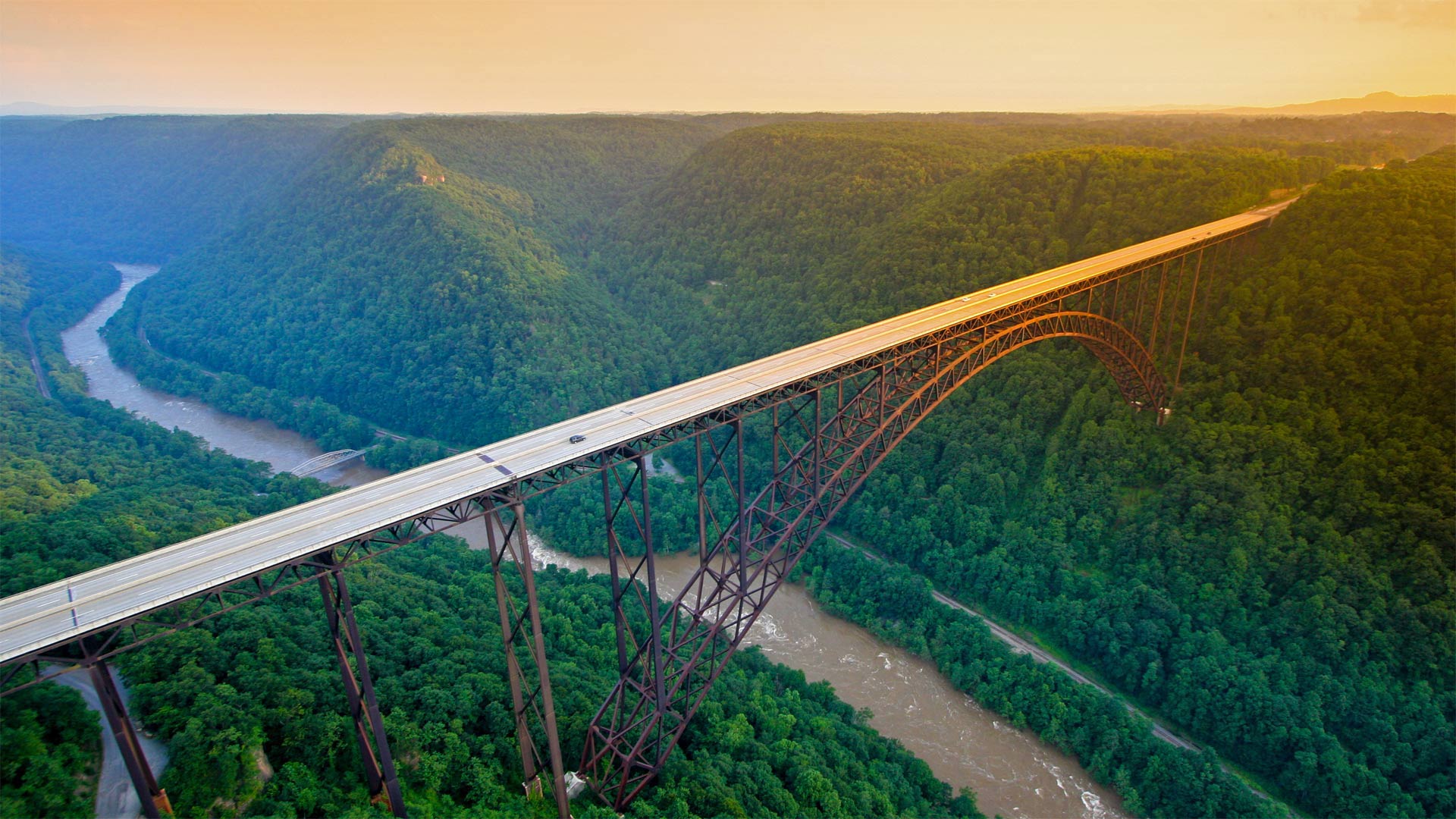
新河峡国家公园中的新河峡大桥,西弗吉尼亚州 New River Gorge Bridge in the New River Gorge National Park and Preserve, West Virginia (© Entropy Workshop/iStock/Getty Images Plus)
A river runs through it
To kick off National Park Week, which begins today, we're visiting America's newest national park, the New River Gorge National Park and Preserve, in West Virginia. This incredible view is of the New River Gorge Bridge, which, when completed in 1977, was the world's highest bridge carrying a regular roadway. It held that distinction for 24 years and is now a popular attraction for BASE jumpers and rappelers.
Far below the bridge is the New River, which—despite its name—is the second oldest river in the world. Its exact age is unknown, but geologists believe the New River is a segment of the preglacial Teays River, which fossil evidence suggests could be 320 million years old. Today, rafters and kayakers come to ride the New River rapids, which can reach a level of Class V, which means they're among the most difficult waters to navigate.
一条河穿过它
为了拉开今天开始的国家公园周的序幕,我们将参观美国最新的国家公园,西弗吉尼亚州的新河峡谷国家公园和保护区。这是令人难以置信的观点是新河峡谷大桥,这是在1977年建成时,世界上最高的桥梁进行定期道路。24年来,它一直保持着这一殊荣,现在已经成为跳垒和饶舌的热门景点。
桥下远处是新河,尽管它的名字是世界上第二古老的河流。它的确切年龄不得而知,但地质学家认为这条新河是前冰期Teays河的一段,化石证据表明这条河可能有3.2亿年的历史。今天,椽子和皮划艇来乘坐新的河流急流,这可以达到五级水平,这意味着他们之间的最困难的水域航行。
Areuse峡谷的Saut du Brot石桥,瑞士纳沙泰尔 Saut du Brot stone bridge in the Areuse Gorge, Neuchâtel, Switzerland (© Andreas Gerth/eStock Photo)
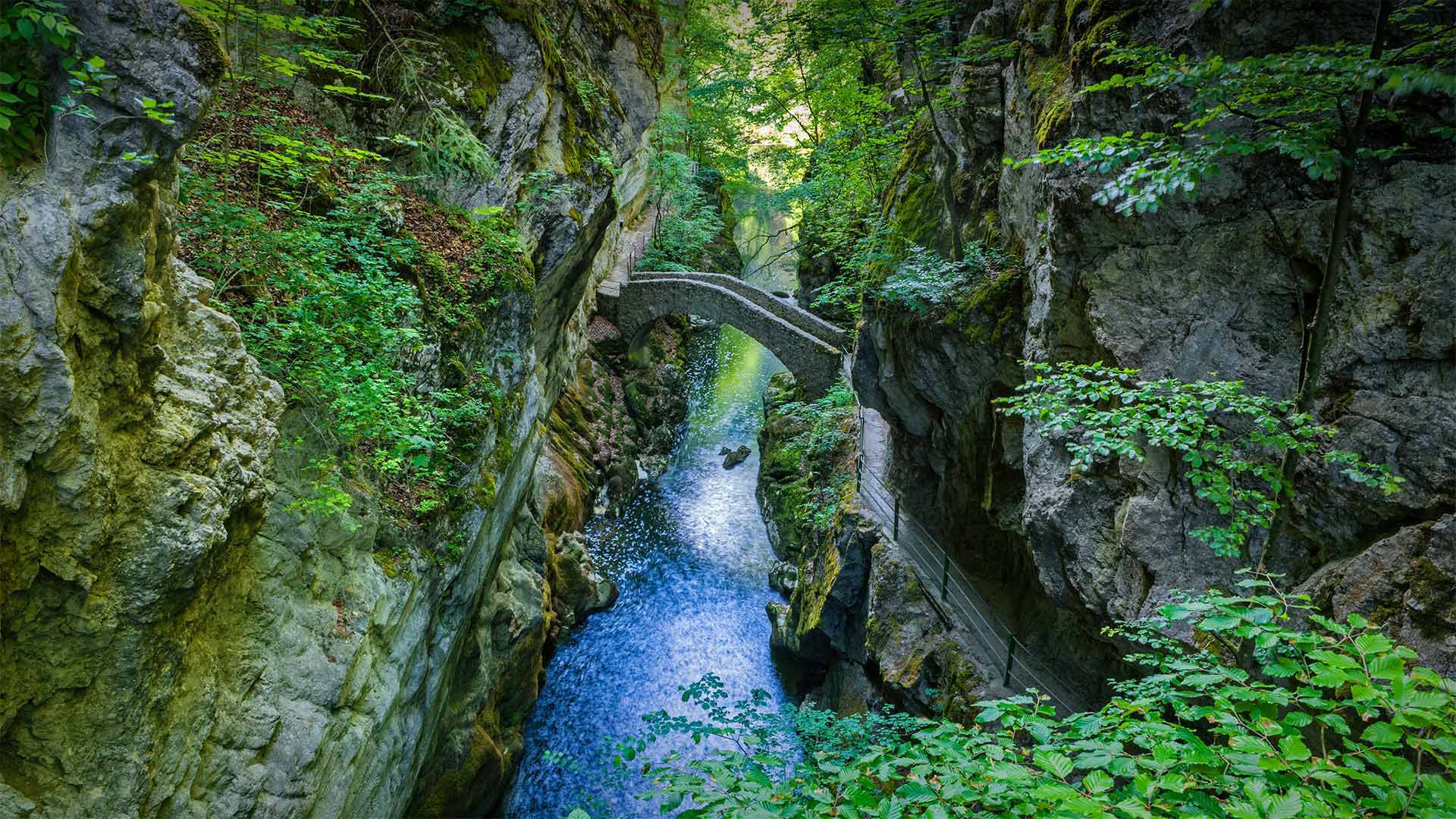
Areuse峡谷的Saut du Brot石桥,瑞士纳沙泰尔 Saut du Brot stone bridge in the Areuse Gorge, Neuchâtel, Switzerland (© Andreas Gerth/eStock Photo)
Once upon a time there was a bridge…
Although this stone bridge, known as Saut de Brot, looks right out of a fairy tale, it serves a very practical purpose. It connects walking trails on each side of the Areuse Gorge, offering safe passage to hikers exploring the lush Brot-Dessous area in eastern Switzerland, a predominantly French-speaking region of this multilingual country. It's not known when the bridge was built exactly, though it's thought to be a recent construction. But if that's true, how do we not know who built it? All this mystery leads us to suspect it's the work of helpful gnomes and fairies living deep in the Swiss woods.
从前有一座桥…
尽管这座被称为索特德布罗特(Saut de Brot)的石桥看起来就像童话故事,但它有着非常实际的用途。它连接阿瑞斯峡谷两侧的步行道,为徒步旅行者探索瑞士东部郁郁葱葱的布罗特-德索斯地区提供安全通道,这是一个多语种国家的主要法语地区。虽然这座桥被认为是最近才建造的,但不知道它到底是什么时候建造的。但如果这是真的,我们怎么不知道是谁建的呢?所有这些谜团让我们怀疑这是生活在瑞士森林深处的有益的侏儒和仙女的作品。
易北河上的巴斯泰桥,德国撒克逊瑞士国家公园 Bastei Bridge above the Elbe river in Saxon Switzerland National Park, Germany (© Reinhard Schmid/eStock Photo)
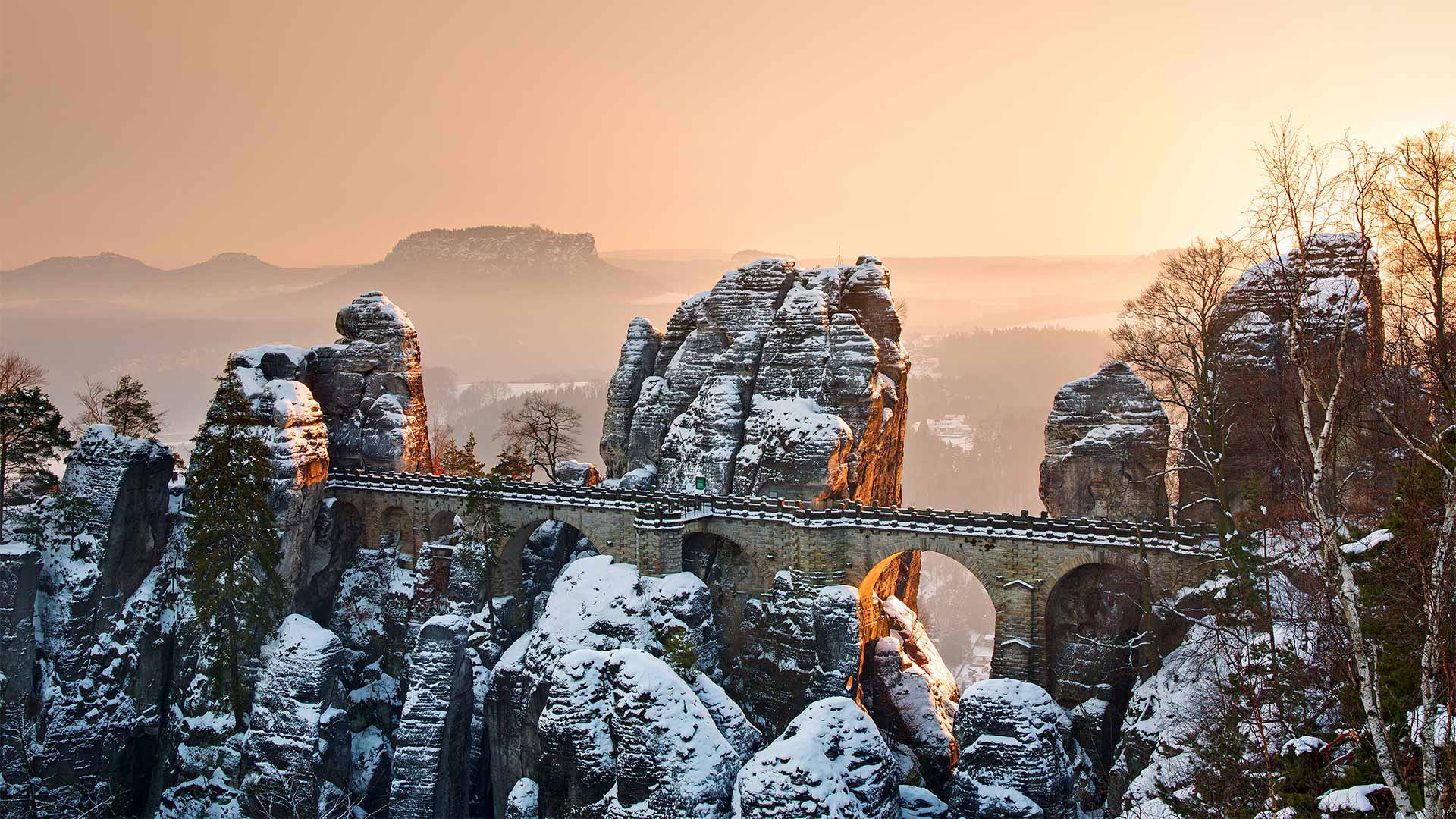
易北河上的巴斯泰桥,德国撒克逊瑞士国家公园 Bastei Bridge above the Elbe river in Saxon Switzerland National Park, Germany (© Reinhard Schmid/eStock Photo)
A bridge that rocks
Sandwiched between soaring pinnacles of sandstone, Bastei Bridge is a highlight of Saxon Switzerland National Park. But don't be fooled by the park's name because we're not in Switzerland; we're hundreds of miles away in eastern Germany, close to the border of the Czech Republic. The name comes from two Swiss artists who visited the area in the second half of the 18th century and felt the picturesque upland scenery was reminiscent of their homeland.
The park boasts untamed forests and spectacular rock formations, including the Bastei in our photo. The rock pillars here were formed by water erosion over a million years ago and tower 636 feet above the Elbe, one of the major rivers in Central Europe. If you're not afraid of heights, you can walk the bridge that has connected these jagged rocks for almost 200 years. Originally made of wood but rebuilt with stone in 1851 to accommodate the increasing tourist traffic, Bastei Bridge offers stunning panoramic views of the river and surrounding Elbe Sandstone Mountains. It also leads to the remains of an ancient castle that once stood here and is now an open-air museum.
岩石桥
巴斯泰桥夹在高耸的砂岩尖顶之间,是撒克逊瑞士国家公园的一大亮点。但不要被公园的名字欺骗了,因为我们不在瑞士;我们在几百英里之外的德国东部,靠近捷克共和国的边界。这个名字来自两位瑞士艺术家,他们在18世纪后半叶造访过这个地区,他们觉得风景如画的高地风景让人想起了他们的家乡。
这个公园拥有未经改造的森林和壮观的岩层,包括我们照片中的巴斯泰。这里的岩柱是由一百万年前的水蚀形成的,耸立在易北河上方636英尺处,易北河是中欧主要河流之一。如果你不怕高,你可以走过这座连接这些参差不齐的岩石将近200年的桥。巴斯泰桥最初是用木头建造的,但在1851年用石头重建,以适应日益增长的游客流量,在它上面可以看到令人惊叹的易北河全景和周围的埃尔贝砂岩山脉的全景。它还通向一座古堡的遗迹,该古堡曾经矗立在这里,现在成为了一座露天博物馆。
兰鲁斯特一座名为Pont Fawr的石拱桥,英国威尔士 Pont Fawr, a stone arch bridge in Llanrwst, Wales, UK (© Pajor Pawel/Shutterstock)
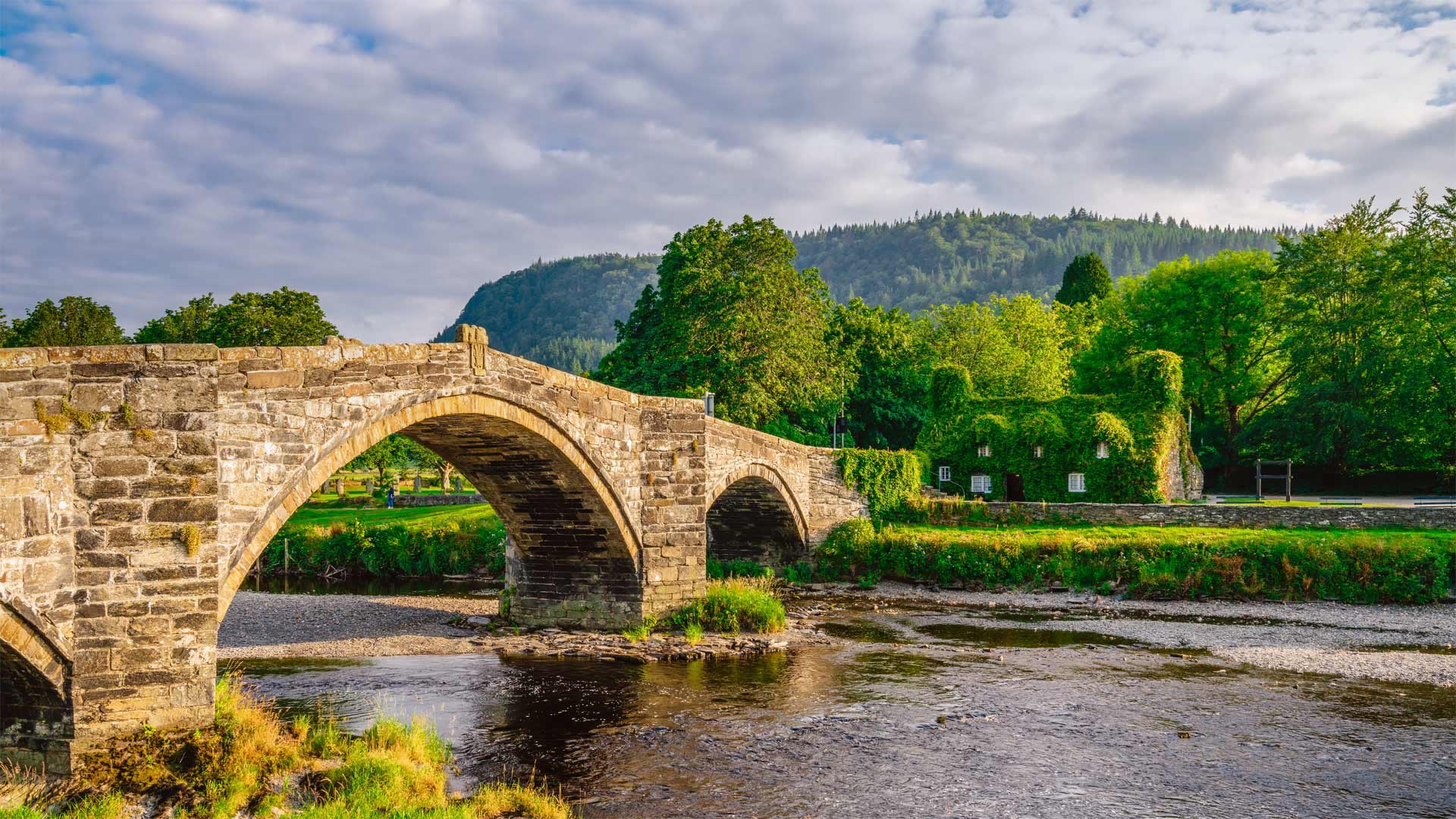
兰鲁斯特一座名为Pont Fawr的石拱桥,英国威尔士 Pont Fawr, a stone arch bridge in Llanrwst, Wales, UK (© Pajor Pawel/Shutterstock)
A bridge too Fawr
How much quaintness can be crammed into one picture? We're pushing the limits with this verdant summer scene in North Wales, looking across the Conwy River from its east bank in the town of Llanrwst. Past the Pont Fawr (Big Bridge) in the foreground, the shrubbery-shrouded cottage dubbed Tu Hwnt I'r Bont (Beyond the Bridge) seems to sprout straight from the grass. Built in the 15th century as a farmhouse, it's now a traditional Welsh tearoom serving up scones to locals as well as visitors bound for nearby Snowdonia National Park.
The Pont Fawr is itself the stuff of history: Built in the 1630s, it's often called the 'Inigo Jones bridge' after the pioneering early modern architect who, legend has it, designed the triple-arch span that today carries motor traffic. A one-way bottleneck along an otherwise two-way main road, the bridge's humped shape tends to obscure oncoming cars, earning it yet another local nickname: Pont y Rhegi (Bridge of Swearing).
